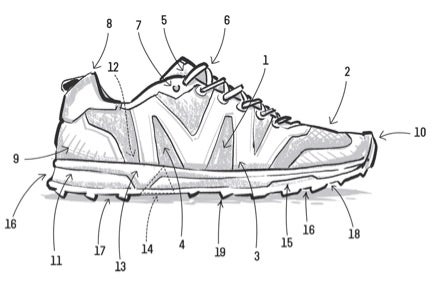New perk! Get after it with local recommendations just for you. Discover nearby events, routes out your door, and hidden gems when you sign up for the Local Running Drop.
Gather up a group of trail runners, and soon enough the talk will turn to shoes. Minimal shoes. Maximal shoes. No shoes. Choices for footwear run the gamut from stiff and burly to super-cushed-out to thin-soled and form-fitting. The key is finding the shoe that works for you and your personal needs.
You can run on a trail in road running shoes. However, shoes specifically made for trail running are generally more stable, protective, sure-footed and durable. Here’s all the lingo you need to know:
1. Upper: The parts and materials that wrap around the top and sides of your foot.
2. Closed mesh: Tighter-woven mesh than you’d find on a road running shoe, intended to keep out trail gunk.
3. Overlays: Materials sewn or welded to the otherwise soft and flexible upper, meant to provide structure and stability. Trail shoes often have more overlays than do road running shoes.
4. Sidewall: The side of the shoe surrounding your arch and the side of your foot. Trail shoes generally offer more sidewall protection than do road shoes.
5. Tongue: The part of the upper that lies under the laces. The tongue of some trail running shoes is connected to the upper to help keep out debris.
6. Laces: Stringy things that tie up your shoes. Some laces tighten and secure with one pull, eliminating the need to tie.
7. Eyelets: The holes that the laces pass through.
8. Collar: The opening in the upper where your foot enters the shoe, usually padded for comfort.
9. Heel counter: A firm, plastic, cup-shaped piece often sandwiched between soft materials around the back of your heel, intended to provide stability and help your foot track straight with each step. Not found on all shoes.
10. Toe bumper: Rubber or plastic on the front of the shoe meant to protect toes from getting stubbed on rocks and roots. Made of varying degrees of burliness, from soft rubber to hard plastic. Not found on all shoes.
11. Midsole: Containing the shoe’s cushioning, the midsole lies between your foot and the shoe’s outsole. It is made of foam for softness and cushioning, and sometimes stability, and provides underfoot protection.
12. Insole: A thin, usually removable, piece of foam inserted inside the shoe. Insoles vary in thickness and amount of arch support, and some have special anti-stink treatments.
13. Cushioning: Soft foam in the midsole and padding around the heel collar and in the tongue. Amount of cushioning varies among shoes.
14. Medial post: A firm piece of foam or rubber near the center of the medial side of trail shoe midsoles, meant to provide midfoot stability. Not found on all shoes.
15. Rock plate: A thin, hard, yet flexible piece of material, usually made of plastic, sandwiched between the shoe’s outsole and midsole. Intended to block sharp objects from jabbing soles. Not found on all shoes.
16. Offset: The difference in height between the heel and the toe. Also called the “drop.”
17. Outsole: The underside of a shoe; the part that hits the ground. Made of some combination of varying types of rubber.
18. Flex grooves: Cuts strategically placed in the outsole to allow the shoe to flex with your foot.
19. Lugs: Rubber protrusions located on the outsole and varying in size, shape and quantity. Designed to provide better grip on trail surfaces.
Read More About Trail Gear:
The Top Trail Running Shoes To Invest In
The Fashionistas Of Trail Running
